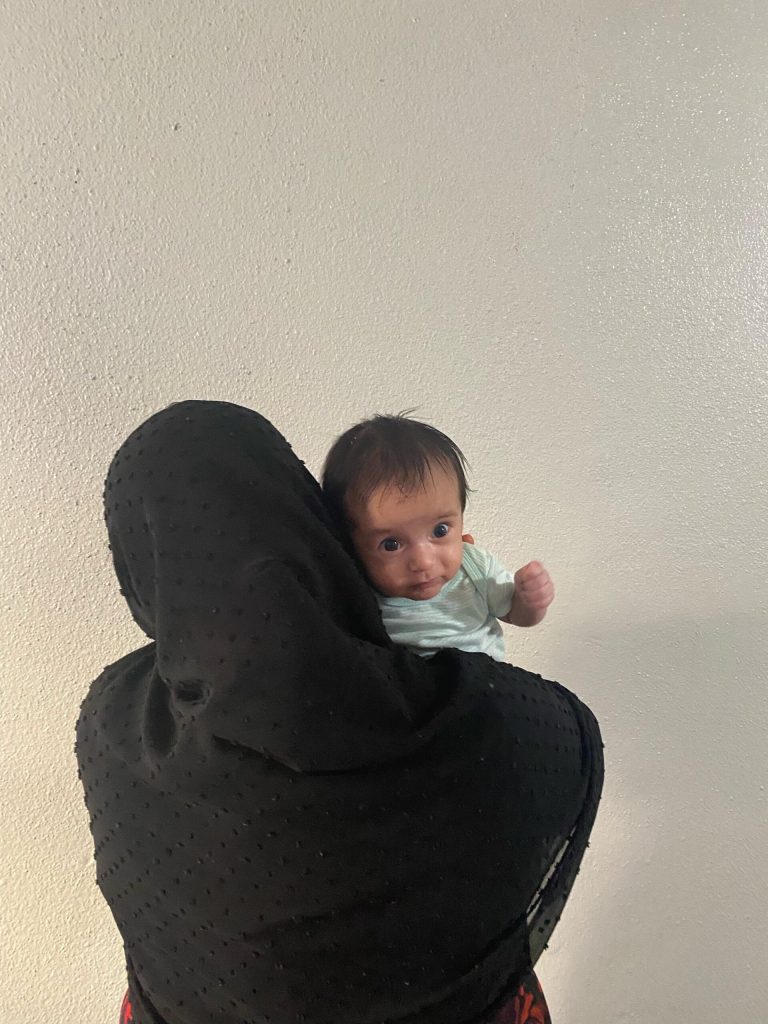Afghan mom had to decide whether to forgo escape — or leave some of her kids behind

In one hand, she held the key to her escape from Afghanistan: travel documents. In the other arm, her 2-year-old daughter, who everyone in the family affectionately calls “the baby girl.”Lal Mohammad, Nasema’s brother, trailed behind her with her four other children, ages 6 to 11. They were hoping, with no guarantee of getting on an evacuation flight that day, to make the journey that thousands of Afghans have now taken to get to the US, circumnavigating half the globe after an abrupt and unceremonious They were working their way through the mass of people descending on the perimeter of Hamid Karzai International Airport, trying to escape before the last US plane left, when The pin was a gas station 15 minutes outside of the airport. Moulton’s Marine contact had come through — maybe. It depended on Suarez wrangling six groups, including Noor’s family, in time to get to the rendezvous point at the gas station and then through a back gate at the airport.”I’m at the gate,” the Marine in Kabul had texted Suarez. “I’m gonna send a guy by the name of ‘Omar.’ He’s gonna ask who knows ‘Tom Brady.'”As Suarez had read the instructions she’d actually laughed out loud at the Massachusetts reference. She told her contacts to respond, “I do.”Meanwhile, each family had to figure out how to get to the gas station. Noor started planning: they would need two taxis, at least. It would take them about 30 minutes to get there from their hideout in the city, maybe less. It would be close. He cursed the fact he wasn’t there to make it happen.Nighttime, KabulNasema had regrouped with her family in a safe place away from the airport after the suicide bombing thwarted their initial attempts to escape. Noor contacted the family to tell them they had only about half an hour to get to the gas station. A bus would be waiting for them. “It could be your last chance,” he told them, reiterating Suarez’s warning.Nasema and her family — including her sister, three brothers, her mother, her toddler and her four other children — waited for the taxis in the dark.Nasema’s children were happy as they made their way to the gas station, but she was anxious: “I was thinking maybe it’s the time for us to die — or get on the flights to leave the country.” They were met by men with beards, according to Lal. The men were in camouflage uniforms, but different from the ones they’d seen American service members wearing as they processed people through the airport. American Special Forces, Lal thought, though he could not be sure, along with Afghan Special Forces.At some point, Lal said, the Afghan soldiers who were interpreting for the Americans left the gas station, and communication broke down. So the reasons for what happened next remain unclear.Nasema approached the Americans for security checks and identification. It became apparent that the Americans had not expected her to bring five children with her.Her missing documents were a problem, too, but three letters she carried from Noor’s military friends gave her some credibility with the US forces. The letters included the names and birth dates of each of Noor’s immediate family members. They did not include the names of Nasema’s children, however. “I was trying to point my children to them but had no way of communicating with them as I was crying,” she said. Her toddler clung to her and her other children started crying. She said the Americans walked away to talk among themselves and, using gestures, communicated to her that she could bring her toddler but not the other kids.”They probably have a child of her age,” she said, “I am not sure why the others couldn’t come.”Nasema contacted her husband, who was in Dubai for work, and asked what she should do. He encouraged her to get on the bus with the 2-year-old and assured her they would be able to get the other children to the US soon.As she looked at her children and held her toddler, she made the impossible decision.As she recalls the moment, Nasema weeps. She talks to her children who were left behind — and are being cared for by a relative — every day on the phone.Noor says he’s doing everything he can to get the other kids out. “The kids, they want their mom,” Noor said. “They say, ‘When are we going to be there with you to join you?'”A cold night in WisconsinNasema cried all the way to Qatar, the first stop over the course of the two weeks it would take to get to America. Next was Spain, where they received ill-fitting clothes at a military base. Their penultimate stop: Nasema bundled up in blankets on a cot, thankful she was in America, but missing her children. The next day, one of the Afghans brought in a service member to turn on the heater.Nasema’s back hurt. She went to the on-post doctor, who checked her out, told her that her baby was fine and gave her some medicine for her back. Her state of mind at Fort McCoy was a combination of constant anxiety and crushing boredom. Resettlement was uncertain to Nasema. Rumors floated around the camp that they could be relocated to the area outside the base.”The information we needed was not there and we would keep asking people around, but there was not a clear answer of what we were to do,” she said.Noor knew all about visas and immigration from his own experience. He assured his family that he would come to get them, but they must wait until their processing was complete.After six weeks, Noor’s family joined the nearly 5,000 other Afghans who had been resettled from Fort McCoy to 46 states as of December, according to a State Department spokesperson.In October, Noor drove the 1,200-odd miles to Fort McCoy to pick up his family.’Beyond crisis’ in Houston”Crisis is a permanent state of what we do,” said Dario Lipovac, refugee resettlement director for YMCA International Services of greater Houston, “but the last couple months, maybe three months, have been beyond crisis.”The agency usually processes a trickle of mostly Syrian, Congolese, Guatemalan and Cubans seeking refuge in America. But in November alone, the organization processed 481 Afghans to Houston, Lipovac said, twice as many as in the last two years combined.With each family comes a need for mattresses, housing, clothing, toiletries, child care, furniture, rugs, cell phones, laptops, blankets, assistance with school enrollment and medical care. It’s not unusual for Lipovac to be up at 3 a.m., organizing information on clients.”You have to be crazy to do this to yourself,” he said. And invested. Lipovac was a refugee himself. In the 1990s he escaped the Balkan conflict and now he helps other people through the tumultuous experience of leaving their countries and resettling in America. The YMCA and three other Houston resettlement groups have raised millions to support Afghans moving to their city. In December, Houston’s resettlement leaders said they were eating much of the up-front costs, with federal funding to be reimbursed later. The rush to fundraise matched the influx of Afghans arriving in the city as local groups met the challenge to facilitate both.As of Tuesday, more than 68,000 Afghan evacuees had been resettled in the US, according to the Department of Homeland Security, with about 7,300 remaining on military basesBy the end of the US military base resettlement, Houston agencies expect to have received 6,000 Afghan refugees, with Lipovac estimating that the YMCA will have received 1,500 — including Noor’s family.Lipovac says Noor’s family are the lucky ones: They have him, someone stateside, to shepherd them through the adjustment, find them an apartment.The newest AmericanNasema’s mind was solely focused on her children as she was entering this entirely new world. But she noted women walking throughout Houston by themselves and she admired the tall buildings on the way to their new apartment.”I wish we had this in Afghanistan,” she said. “I wish people would allow women to practice their freedom. I wish there was no fighting, there was no bomb explosions, that there was no stress in our country.”As she was looking and wondering, she thought of her kids: “I wish I had them by my side so we could see the city together.”Outside the apartment, Noor’s 2-year-old niece is stomping around barefoot on the patio as laundry hangs on lines above the concrete. She follows behind her uncle toward the front of the house, where two slightly older Afghan boys are running around shooting bubbles out of a toy gun. She giggles as they chase each other back and forth. There are three Afghan families on the street, including Nasema’s, which is a big reason that Noor chose this neighborhood.”They’ve been helpful. Some of them got here two years ago, one year ago, and are in a different situation,” he said. “But it’s a traditional thing for Afghans, sometimes when they cook good food they bring a plate or two plates over to my family. When my family cooks good food we take it to the neighbors.”In the living room, Nasema’s mother and sister pray on intricate rugs that cover the dark vinyl flooring. In the corner of the room, Nasema’s new baby is propped up by small pillows on a large round table, sucking on a pacifier.He was born a healthy 7 pounds, 1 ounce, and two weeks earlier than expected, just in time for the family’s first Thanksgiving.The baby’s name is Wisal, to represent Nasema’s hope for the future. It only roughly translates to English, with nuanced uses in Afghan poetry and literature. But to Nasema, it means the joining of separate people or objects — reunion, specifically.It is what she prays for every day.






